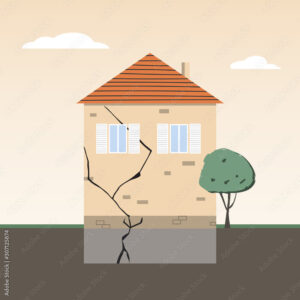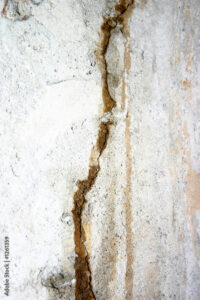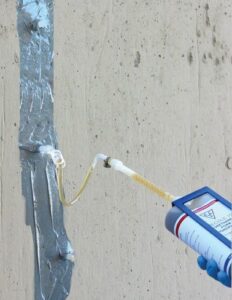Your home’s strength starts from the bottom-up, quite literally. The foundation, the unsung hero of every residence, is what keeps your walls upright, your roof where it should be, and your family safe and sound. But just like any tale of heroism, even the sturdiest of foundations aren’t invincible. When cracks appear, it’s a homeowner’s call to action. This is where DIY epoxy injection for foundation cracks steps into the scene.
For the savvy homeowner or DIY enthusiast, the concept of wielding epoxy might seem daunting at first—a highly specialized solution for what feels like an exclusively contractor-level issue. However, advances in technology, coupled with a bit of guidance, make this repair method more accessible than you might think.
In this comprehensive guide, we dispel the myths, unravel the process, and weigh the advantages and disadvantages of taking on a DIY epoxy injection for your basement foundation cracks. Ready to take charge and become your own home repair hero?
 Understanding Foundation Cracks
Understanding Foundation Cracks
Before we strap on our DIY capes, it’s crucial to first understand the enemy we face. Foundation cracks come in various forms and are typically symptoms of underlying issues. Some key types of foundation cracks include:
- Vertical Cracks: Often a sign of a settling foundation
- Horizontal Cracks: More serious, often from hydrostatic pressure
- Diagonal Cracks: Usually due to a combination of settling and lateral pressure
Each type differs in severity, depth, and potential harm. To properly diagnose the cause and solution, homeowners should pay particular attention to the shape, location, and direction of the crack.

When to DIY
Not all foundation cracks are equal, and neither are the solutions. Some can be indicators of serious structural issues that require professional assessment and repair. However, for hairline cracks and minor concrete defects, a DIY epoxy injection may be a cost-effective and preemptive solution.
Gear up for Safety
Safety should always lead the charge in any DIY project. Special gloves, eye protection, and a well-ventilated area are non-negotiable. Though epoxy is not as noxious as in times past, it’s still a chemical compound that requires respect and careful handling.
Follow and subscribe to our YouTube channel for tons of Great information.
Websiteconstructionconsumeradvocacyinstitute.com
Podcastanchor.fm/galloway
www.youtube.com/@ConstructionConsumerAdvocacy
 The DIY Epoxy Injection Process
The DIY Epoxy Injection Process
Gather Your Supplies
Successful DIY projects are launched from the back of preparation. You’ll need a few key items:
- Epoxy Resin: A high-strength adhesive suited for concrete
- Epoxy Ports: Small plastic tubes that are placed along the crack to direct the resin
- Epoxy Injection Gun: A tool to precisely dispense the epoxy into the ports
- Surface Sealant: Keeps the epoxy from seeping out of the crack
Preparation is Key
Clean the crack of any debris using a wire brush or compressed air. The crack’s surface must be dry—you may need to use a hairdryer to ensure it. Once cleaned, apply the surface sealant to prevent the epoxy from flowing out.
 Injecting the Epoxy
Injecting the Epoxy
With the ports attached, use the epoxy injection gun to dispense the resin into the crack. Start at the lowest port and work your way up, utilizing a consistent pressure to fill the space completely without overloading or creating voids. This step is delicate; precision and patience are your allies.
 Curing Time
Curing Time
Epoxy doesn’t fix foundation cracks like a flip of a switch. The curing time is critical to the epoxy’s final strength. It’s advised to leave the injected epoxy for at least a day before removing the surface sealant and ports.
Weighing the Advantages
Cost Savings
DIY epoxy injections are markedly cheaper than hiring a professional. However, it’s essential to acknowledge the trade-off of price for quality and potential risk.
Time Efficiency
With a DIY kit, repairs can be completed in a matter of hours. By comparison, contracting a professional could mean waiting weeks for an opening in their schedule.
Learning and Satisfaction
Undertaking the epoxy injection yourself is a learning opportunity. You gain firsthand experience in addressing a foundational issue and a profound sense of accomplishment once the repair is complete.
Follow and subscribe to our YouTube channel for tons of Great information.
Websiteconstructionconsumeradvocacyinstitute.com
Podcastanchor.fm/galloway
www.youtube.com/@ConstructionConsumerAdvocacy
Considering the Disadvantages
Risk of Improper Installation
The effectiveness of an epoxy injection is contingent on its proper installation. Failing to fill the crack adequately or contaminating the epoxy can render the repair ineffective.
Voiding Home Warranties
If your home is still under warranty, performing major repairs yourself could void its protection. Always consult your warranty’s terms before tackling any project, especially around the foundation.
Decline in Home Resale Value
While a well-executed epoxy repair can stabilize a foundation, a poor DIY job can have the opposite effect, undermining your home’s resale value.
Combating Misconceptions
Professional Help is Irreplaceable
DIY enthusiasts often shy away from foundation repairs, assuming the complexity demands a professional touch. While this is true for many situations, the advent of DIY kits allows homeowners to tackle less severe issues with relative ease.
One Fix for All Cracks
Epoxy injection is a powerful solution for certain types of cracks but not every crack. It will not correct the underlying issues that led to the cracks forming in the first place, and it’s important to know its limitations.
A Closer Look at Epoxy Injection Kits
Epoxy injection kits come in various sizes and brands, but most contain:
- Epoxy resin
- Epoxy ports
- Injection gun
- Surface sealant
- Gloves and safety equipment
Before purchasing a kit, research and reviews are your allies. Ensure the kit matches the scope of your project and that the epoxy resin is suitable for your specific type of foundation crack.
Conclusion: Is DIY Epoxy Injection Right for You?
A homeowner’s decision to tackle a DIY epoxy injection is nuanced and multifaceted. It’s not a one-size-fits-all solution, but for small cracks and proactive maintenance, it can be a game-changer.
Remember to always assess the crack and its severity before proceeding. If the issue is beyond the scope of DIY, calling in a professional is the wisest course of action.
For fearless DIY enthusiasts, mastering the epoxy injection process could save you time and money while fostering a deeper, more empowered connection with your home. It’s a powerful tool in the homeowner’s arsenal—one that demands respect, precision, and a foundation of knowledge to wield effectively.
In stepping up to confront the cracks in your abode, you become the sculptor of your dwelling’s durability. With the right balance of caution and confidence, DIY epoxy injections can cement a sense of control and security over your home’s foundational health.
Follow and subscribe to our YouTube channel for tons of Great information.
Websiteconstructionconsumeradvocacyinstitute.com
Podcastanchor.fm/galloway

